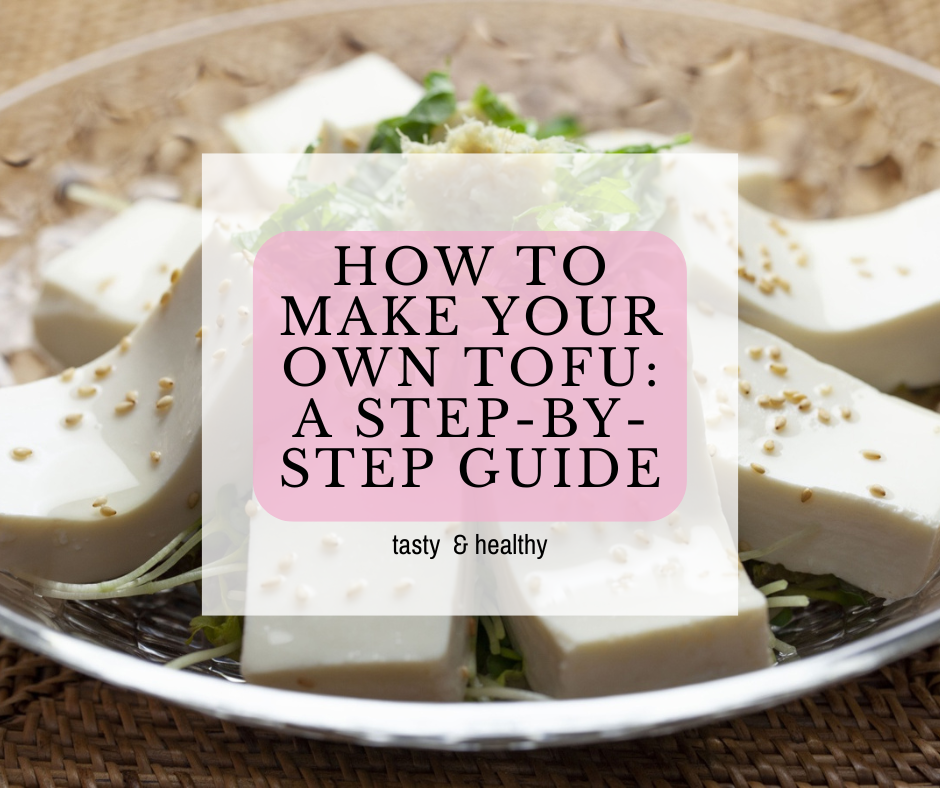
How to Make Your Own Tofu: A Step-by-Step Guide
Tofu is a plant-based protein that we can make from soybeans. It is also known as bean curd and has been a staple ingredient in Asian cuisine for centuries. To make it, we have to soak soybeans, ground and then cook them in water to produce a milky liquid called soy milk. This liquid is then curdled using a coagulant such as calcium sulfate or magnesium chloride. It causes the protein in the soy milk to solidify and form into curds. The curds are then pressed and shaped into blocks or other forms.
Tofu is an important source of protein in the vegan and vegetarian diet. It is a complete protein, meaning it contains all nine essential amino acids that the body needs to function in a proper manner. It is also low in fat and calories, making it a great option for those who are looking to maintain a healthy diet. Besides to being high in protein, it is also a good source of essential vitamins and minerals.
Tofu is a versatile ingredient that we can use in a variety of dishes. It includes stir-fries, soups, salads, and sandwiches. We can season and flavour it in many different ways. This makes it a delicious and nutritious addition to any meal. Its neutral taste and texture also make it a popular meat substitute for those who are transitioning to a vegan or vegetarian diet.
Benefits of making your own tofu
Making your own tofu has several benefits, including:
- Freshness: Making it on your own allows you to use fresh, high-quality ingredients. It ensures that you have the freshest tofu possible. Store-bought tofu may have been sitting on the shelf for some time and may not be as fresh as homemade tofu.
- Control over ingredients: When you make your own tofu, you have control over the ingredients that go into it. This is important if you have dietary restrictions or preferences. You can also avoid additives and preservatives that may be present in store-bought tofu.
- Cost-effective: Making your own tofu can be a cost-effective option. It makes lot of difference if you consume a lot of it. Buying soybeans in bulk and making your own can be cheaper than buying pre-made from the store.
- Eco-friendly: Making your own tofu can be an eco-friendly option. It reduces the amount of packaging and transportation involved in buying store-bought tofu.
- Creativity: Making your own tofu allows you to be creative with flavours and textures. You can experiment with different coagulants and seasoning to make tofu. It depends on your taste preferences.
Making your own tofu can be a rewarding and enjoyable experience. It can provide many benefits beyond having a delicious and nutritious food option.
Equipment and Ingredients Needed
A. List of required equipment:
- Soybeans (dried or fresh)
- Water
- Coagulant (such as calcium sulfate or magnesium chloride)
- Cheesecloth or nut milk bag
- Blender or food processor
- Large pot
- Thermometer
- Tofu mould or a sturdy rectangular container with drainage holes
- Weight (such as a heavy can or jar)
B. Where to find the necessary equipment:
- Soybeans are available at most grocery stores or online.
- Coagulant is available at specialty food stores or online. Some common brands include Nigari and Gypsum.
- Cheesecloth or nut milk bags may be available at most grocery stores or online.
- We can find the moulds at Asian grocery stores or online. A sturdy rectangular container with drainage holes can also help in making tofu.
C. Types of soybeans for tofu making:
There are several different types of soybeans that we can use for making it, including:
- Yellow soybeans: These are the most common type of soybeans used for making it. They have a mild flavour and produce a creamy tofu.
- Black soybeans: These have a nuttier flavour and produce a firmer one.
- Green soybeans: These have a sweeter flavour and produce a softer one.
- Fresh soybeans: These can be used to make fresh tofu. It has a sweeter, creamier flavour than dried soybeans.
It is important to note that the type of soybeans used will affect the texture and flavour. So, it is important to choose the type of soybeans based on personal preference.
Preparing the Soybeans
A. How to soak and cook the soybeans:
- Rinse the soybeans and remove any debris.
- Soak the soybeans in water for at least 8 hours, or overnight.
- Drain the soybeans and rinse them again.
- Place the soybeans in a large pot and add enough water to cover them by about an inch.
- Bring the water to a boil and then reduce the heat to low.
- Simmer the soybeans for 2-3 hours, or until they are very soft and mashed with a fork.
- Drain the soybeans and reserve the cooking liquid, which we can use to make soy milk.
B. Importance of preparing the soybeans for making it:
Preparing the soybeans is crucial for making good quality one. Soaking the soybeans softens them and makes them easier to cook. It results in a smoother and creamier one. Additionally, cooking the soybeans ensures that the final product is safe to consume. It reduces the risk of any digestive issues that may arise from consuming undercooked soybeans. Using high-quality soybeans and proper preparation will give a better texture and flavour. Thus, it is important to take the time to soak and cook the soybeans to achieve the best results in making it.
Grinding and Straining the Soy Milk
A. How to grind the soybeans to make soy milk:
- Transfer the cooked soybeans to a blender or food processor.
- Add water to the blender or food processor, using a 1:3 ratio of soybeans to water.
- Blend the soybeans and water on high speed for 1-2 minutes, or until the mixture is smooth and creamy.
- Pour the mixture into a large pot.
B. How to strain the soy milk using cheesecloth or a nut milk bag:
- Place a cheesecloth or nut milk bag over a large bowl or pot.
- Pour the soy milk into the cheesecloth or nut milk bag.
- Gather the ends of the cheesecloth or nut milk bag and twist to squeeze out as much liquid as possible.
- Discard the leftover soy pulp or save it for other recipes.
C. Importance of getting a smooth and clean soy milk for the next step:
Getting a smooth and clean soy milk is important for the next step in the tofu-making process. It affects the texture and flavour of the final product. If the soy milk is not strained in a proper manner, it may contain soy pulp or other impurities. This can result in a grainy or gritty tofu. Additionally, any leftover soy pulp can interfere with the coagulation process. This can prevent the soy milk from setting into tofu. So, it is important to strain the soy milk in a thorough manner. This will ensure that it is smooth and free of any impurities before moving on to the next step in the tofu-making process.
Coagulating the Soy Milk
A. Process of coagulating the soy milk:
- Heat the soy milk in a large pot until it reaches a temperature of 170-180°F.
- While stirring the soy milk, add the coagulant and continue stirring for a few seconds.
- Turn off the heat and cover the pot with a lid.
- Let the mixture sit undisturbed for 10-15 minutes to allow the curds to form.
B. Different types of coagulants that we can use:
There are several types of coagulants that we can use for making tofu. It includes nigari, gypsum, lemon juice and vinegar. Nigari is a traditional Japanese coagulant made from seawater that contains magnesium chloride. Gypsum is a natural mineral that contains calcium sulfate. Lemon juice and vinegar are acidic coagulants that work by lowering the pH of the soy milk. Each coagulant has a different effect on the texture and flavour of the final product.
C. Importance of measuring the coagulant to achieve the desired firmness :
Measuring the coagulant is important for achieving the desired firmness. Using too little coagulant will result in a soft and crumbly tofu. At the same time using too much will result in a dense and rubbery one. It is important to follow a recipe or experiment with different amounts of coagulant. This will help to find the right balance that produces the desired firmness and texture. Additionally, the type of coagulant used can also affect the firmness and flavour. So, it is important to choose a coagulant that works well with the desired recipe.
Pressing and Moulding the Tofu
A. Importance of pressing to remove excess water:
Pressing the tofu is an important step in the making process. It removes excess water from the curds and helps to firm up. Without pressing, the tofu may be too soft and fragile, making it difficult to handle and cook with.
B. How to use a tofu press or a homemade press to remove water:
There are two common methods for pressing tofu – using a tofu press or making a homemade press. To use it, follow these steps:
- Cut it into the desired shape (e.g., blocks, cubes, slices).
- Place it in the press and tighten the screws or clamps to apply pressure.
- Let it sit for at least 15-30 minutes to remove excess water.
To make a homemade press, follow these steps:
- Wrap the tofu in a clean kitchen towel or cheesecloth.
- Place the wrapped one on a plate or cutting board.
- Place a heavy object (e.g., cast iron skillet, canned food) on top of the wrapped one to apply pressure.
- Let it sit for at least 15-30 minutes to remove excess water.
C. Importance of using a mould to shape the tofu:
Using a tofu mould is important for shaping the tofu into the desired form and size. It also helps to further press out excess water and ensure a smooth and uniform texture. We can make a mould with various materials such as plastic, ceramic or stainless steel. It is usually a box-shaped container with small holes that allow the water to drain out while it sets. We can buy a mould online, in some health food stores or in Asian markets. Once we press the tofu, we can place it in the mould and leave to set for a few hours or overnight. After setting, we can remove the tofu from the mould and used in a variety of recipes.
Cutting and Storing
A. How to cut it into desired shapes and sizes:
Once we press and mould the tofu, we can cut it into desired shapes and sizes. Some common shapes include cubes, slices, and triangles. To cut tofu, use a sharp knife and a cutting board. It is best to cut the tofu into smaller pieces to use in recipes. If the tofu is too soft or crumbly, it may be helpful to freeze it for a short time before cutting to make it firmer.
B. Best way to store it to maintain its freshness:
To maintain the freshness of tofu, it is best to store it in the refrigerator. First, wrap the tofu in a paper towel or clean kitchen towel to absorb any excess moisture. Then, place it in an airtight container or wrap it in plastic wrap. Try to consume tofu within 3-5 days after opening the package. If the tofu is not used within this time, we can deep freeze it for up to 5 months. To freeze tofu, first cut it into desired shapes and sizes. Wrap it in plastic wrap or an airtight container. Then place it in the freezer. When ready to use, thaw the tofu in the refrigerator overnight before cooking with it.
FAQ’s:
Ans: Making it can be a bit time-consuming and requires some specialized equipment. But the process itself is straightforward and not too difficult. The basic steps involve:
1. Soaking and cooking soybeans
2. Grinding them into a fine paste to make soy milk
3. Coagulating the soy milk using a coagulant
4. Pressing the curds to form
5. Cutting and storing.
We may not find some of the equipment in a home kitchen. They can be a mould and a press. They may be available online or at specialty cooking stores. Additionally, we can do many of the steps involved in making it in advance. They are soaking the soybeans overnight or cooking them earlier in the day.
Making tofu requires some patience and attention to detail. But it is definitely doable for most home cooks who are willing to give it a try. With some practice and experimentation, you can create your own custom-made tofu. It will be fresh, healthy, and free from additives or preservatives.
Ans: You can eat raw tofu as it contains cooked soybeans. The beans are ground into soy milk, curdled with a coagulant, and then pressed into blocks. But it is not recommended to eat it raw for several reasons.
Tofu has a bland taste and a rubbery texture in its raw form, which may not be appealing to many people. Raw one may not be as digestible as cooked one. Some people may experience digestive discomfort or bloating after eating it.
Furthermore, raw tofu may contain harmful bacteria or microorganisms. It can cause foodborne illnesses if not cooked in a proper manner. Cooking tofu helps to improve its flavour and texture. It also helps to kill any bacteria or microorganisms that may be present.
So, we should cook tofu before consuming it to enhance its flavour and texture, as well to ensure that it is safe to eat.
Ans: The firmness of tofu and paneer can vary depending on how we make and how long we press them. In general, tofu is usually softer than paneer, especially the silken tofu variety. But, firmer varieties of tofu such as firm or extra-firm tofu can be quite dense. They have a similar texture to paneer.
Paneer is a type of cheese made by curdling milk with an acidic agent such as lemon juice or vinegar. It is denser and more solid than tofu, but the texture can still vary depending on how we make and how long we press them.
The firmness of tofu and paneer can vary. It depends on how we prepare and adjust them to suit individual preferences.






4 Comments
[…] otherwise called bean curd, is a versatile and nutritious food produced using soybeans. We can make tofu by coagulating soy milk and squeezing the curds into blocks. It is same like the process of making […]
[…] otherwise called bean curd, is a versatile and nutritious food produced using soybeans. We can make tofu by coagulating soy milk and squeezing the curds into blocks. It is same like the process of making […]
[…] a side dish. Tofu is not fermented and a soybean product. The formation is in blocks. The taste of tofu is quite blend, but it can absorb any coating that you add to it. Tempeh contains fermented […]
[…] a side dish. Tofu is not fermented and a soybean product. The formation is in blocks. The taste of tofu is quite blend, but it can absorb any coating that you add to it. Tempeh contains fermented […]